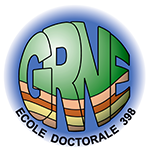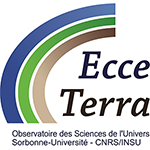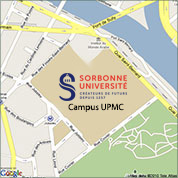Boulila Slah

Equipe : TERRE-MER
Maître de Conférences
Sorbonne Université - Campus Pierre et Marie Curie, Tour 56-66, 5ème étage, Bureau 516, Case courrier 117
Tél : (33) 1 44 27 41 63
Email: slah.boulila @ sorbonne-universite.fr
CV
Born, November 19, 1975, Kerkennah, Tunisia
1996–2001:Engineer in Geo-resources and Environment, INAT-Tunis & ENIS-Sfax, Tunisia
2001–2002:Master 1 in Geosciences, FSS-Sfax, Tunisia
2002–2003:Master 2 in Geosciences (MQMBS), IFP School & ENSMP, Paris
2003–2004:DES in Geosciences, UPMC, Paris
Dec. 2004–March 2008:PhD Thesis in Geosciences, Cyclostratigraphy-Astrochronology, UPMC, Paris.
2007–2009: Two years teaching Geosciences (ATER), UPMC, Paris
Sept. 2009 – March 2010: Post-doc, Cyclostratigraphy, IMCCE, Paris Observatory.
July 2011: Research invitation at Johns Hopkins University, Baltimore, Maryland, USA.
June-July 2012: Participant in IODP342 Expedition JOIDES Resolution, offshore Newfoundland, Canada.
Since April 2010: Permanent Lecturer-Researcher (MC), UPMC-Sorbonne University, Paris.
Research interests
Cyclostratigraphy, time-series analysis, Earth’s orbital (Milankovitch) parameters.
Astrochronology, geological time scale.
Orbitally forced climate and sea level, biogeochemical cycles (esp. multi-Myr variabilities).
Sub-Milankovitch millennial-scale paleo-climatic variabilities.
Rates and forcing processes of paleo-climatic and paleo-oceanic events.
Astrodynamic parameters from cyclostratigraphy (Earth-Moon distance, Solar System planetary orbits).
Causes of paleo-biodiversity over the Phanerozoic (focus on Earth’s interior dynamics)
https://orcid.org/0000-0001-7358-4623
Teaching
Licence 1: UE Géosciences 1 & UE Géosciences 2
Licence 2: UE Base de Sédimentologie et Pétrologie sédimentaire
Licence 3: UE Stratigraphie & UE Environnements sédimentaires
Master 1: UE Paléoclimats & UE Stratigraphie intégrée
Master 2: UE Palaeo3 & UE Enregistrement des cycles sédimentaires
National and international research contributions
2008–2012: ANR Project, Astronomical Time Scale – Cenozoic/Mesozoic, "ASTS-CM", 200 k€. Laskar J., Galbrun B., Boulila S. et al.
Contributions par huit articles comme premier auteur.
July 2011 :NSF Project, Mesozoic ATS (Astronomical Time Scale), Stay at Johns Hopkins University, USA, Hinnov, L. et al.
2011– 2012: INSU-SYSTER Project, biogeochemical cycles, 5 k€. Boulila S., Laskar, J. & Galbrun B.
June-July 2012: Sailing in Leg 342, IODP342, Newfoundland,http://publications.iodp.org/scientific_prospectus/342/
Writing Cyclostratigraphic chapters (in Norris, R.D., Wilson, P.A., Blum, P., and the Expedition 342 Scientists, eds., 2014. Proceedings of the Integrated Ocean Drilling Program, Volume 342: College Station, TX.)
2013–2014: INSU-SYSTER Project, Eocene-Oligocene climates, 5 k€. Boulila S. et al.
2012–2015: Astronomical calibration of the Paleocene-Eocene Thermal Maximum (PETM) from IODP 342 Expedition, U1403-U1409 Sites (North Atlantic Ocean). S. Boulila et al.
Collaborations: Donald Penman (Yale University) and James Zachos (University of California, Santa Cruz).
2014–2015: INSU-SYSTER Project, Carbon-cycle dynamics during the T-OAE from Moroccan sections, 5 k€. Boulila S. et al.
Collaborations: Bruno Galbrun (ISTeP) & Driss Sadki (Moulay Ismaïl University, Meknès, Morocco).
2014–2015: INSU-SYSTER Project, Rhetian ATS, 5 k€. Galbrun, B., Boulila S. et al.
2014–2021: Early Cretaceous ATS from Swiss Pre-Alps. Charbonnier, Boulila, et al.
Collaborations: Charbonnier G., Föllmi K. & Adatte Th. (Lausanne University)
Funding: Lausanne University
2018–2021: Eocene-Oligocene ATS from CDB1 drill-core (Rennes Basin). Boulila et al.
Collaborations: Bruno Galbrun (CNRS, SU), Guillaume Dupont-Nivet (Géosciences de Rennes, UMR 6118) and Hugues Bauer (BRGM, Bureau de Recherches Géologiques et Minières, Orléans).
Since 2015! Secular variations of geomagnetic polarity reversals from ultra-high resolution Eocene sedimentary data from the North Atlantic (IODP Exp. 342). Yamamoto Y., Boulila S. et al.
Collaborations: Yuhji Yamamoto (Kochi University, Japan), Futoshi Takahashi (Kyushu University, Fukuoka, Japan) & Peter C. Lippert (University of Utah, USA).
January 2020-December 2025: ANR AstroMeso (Astronomical Solution for the Mesozoic Era) - Leader du projet : Jacques Laskar (Observatoire de Paris). Fonction dans le projet : Responsable du Partenaire 2 (Sorbonne-Université/ISTEP) - Montant pour le partenaire 2 : 218 k€ (essentiellement pour un post-doc) https://anr.fr/Projet-ANR-19-CE31-0002.
November 2020-October 2026: ERC AstroGeo (Astronomical Solutions over Geological time) - Leader du projet : Jacques Laskar (Observatoire de Paris). Fonction dans le projet : Collaboration par la partie « données géologiques et cyclostratigraphie ». Montant pour le partenaire Sorbonne Université/ISTEP : 185 k€
https://scanr.enseignementsup-recherche.gouv.fr/project/885250
https://www.imcce.fr/news/astrogeo-winner-erc
Since 2008:
(1) Contribute to the construction of the international Geologic Time Scale (GTS), Cenozoic and Mesozoic ATS (Astronomical Time Scale).
Collaborations: Bruno Galbrun (CNRS, SU), Linda Hinnov (John Hopkins, now at Georges Mason University), James Ogg (Purdue University) and Jacques Laskar (Paris Observatory). Une vingtaine de publications de rang A.
(2) Extraction of astrodynamical parameters of Earth-Moon system (2i) and the imprint of the chaos in the Solar System (2ii) from cyclostratigraphic sedimentary records.
Collaborations: Linda Hinnov (Georges Mason University, USA), Bruno Galbrun (CNRS, SU) & Jacques Laskar (CNRS, Paris Observatory). Sur le Point #2i : Deux publications de rang A (2020, 2022) + 1 Nouvelle INSU (2022), le tout comme premier auteur. Sur le Point #2ii : Deux publications de rang A (2023) en deuxième auteur. Nouvelle INSU (2023) + Nouvelle SU (2023) + Nouvelle Observatoire de Paris (2023) comme premier auteur.
Since 2010: The record of sub-Milankovitch, millennial climate variabilities in the Cenozoic and Mesozoic strata.
Collaborations : Bruno Galbrun (CNRS, SU), Silvia Gardin (CNRS, MNHN, SU), Pierre Pellenard (Université de Bourgogne). Boulila et al. Basin Research 2010, Boulila et al. Scientific Reports 2022 + 1 Nouvelle INSU (2022) + 1 Nouvelle SU (2022), le tout comme premier auteur.
Since 2018: Cyclostratigraphy of subsurface seismic and well-log geological data for studying the potential link between orbitally forced climate and sea-level changes. Temporal/age constraints from astrochronology on subsurface data. Studied-explored sites: Cenozoic sedimentary deposits of the Amazon and Nile Rivers.
Collaborations : principal collaborateur Christian Gorini (SU-ISTEP), et plusieurs collègues brésiliens et égyptiens. Co-Encadrement d'une thèse (Lucas Tortarolo, thèse soutenue le 15 décembre 2023) + Deux Master 2 (en 2020). 1 Publication (Boulila et al., Marine Petroleum Geology 2020) + 1 manuscrit soumis à Global Planetary Change (Tortarolo et al. under review).
Since 2020: Exploring the potential link between the macro-evolution of marine life and Earth’s interior dynamics during the course of the Phanerozoic Eon.
Collaborations: Shanan Peters (University of Wisconsin-Madison, USA, https://geoscience.wisc.edu/people/peters-shanan/), Dietmar Müller (Université de Sydney, Australie, https://www.sydney.edu.au/science/about/our-people/academic-staff/dietmar-muller.html), Bilal Haq (Smithsonian Institution, Washington DC, USA, https://en.wikipedia.org/wiki/Bilal_U._Haq) & Juraj Farkas (The University of Adelaide Australia, https://researchers.adelaide.edu.au/profile/juraj.farkas). 3 publications de rang A.
Since 2022: Exploring the tectonic/geodynamic and geochemical evolution of the Earth since its creation. Analysis of huge geological datasets covering several billionyears.
Collaborations : Steve Puetz (USA, https://www.researchgate.net/profile/Stephen-Puetz), Kent Condie (New Mexico Institute of Mining & Technology, USA, https://nmgs.nmt.edu/notablegeologists/Kent_Condie/home.html), Kurt Sundell, Idaho State University, USA, https://www.kurtsundell.com/), Nick Roberts (British Geological Survey, UK, https://www.nickmwroberts.co.uk/), Christopher J. Spencer (Queen's University, Canada, http://tectonochemistry.com/about/). 2 publications de rang A.
Classified list of research publications
- Articles dans des revues internationales à comité de lecture
2008
Boulila S., Galbrun B., Hinnov L., Collin P.Y., 2008a. High-resolution cyclostratigraphic analysis from magnetic susuceptibility in a Lower Kimmeridgian (Upper Jurassic) marl-limestone succession (La Méouge, Vocontian Basin, France). Sedimentary Geology, 203, 54-63.
Boulila S., Galbrun B., Hinnov L., Collin P.Y. 2008b. Orbital calibration of the Lower Kimmeridgian (Southeastern France): implications for geochronology and global sequence stratigraphy. Terra Nova, 20, 455-462.
Boulila S., Hinnov L., Huret E., Collin P.Y., Galbrun B., Fortwengler D., Marchand D., Thierry J., 2008c. Astronomical calibration of the Lower Oxfordian (Terres Noires Formation, Vocontian Basin, France): consequences of revising Late Jurassic time scale. Earth and Planetary Science Letters, 276, 40-51.
2009
Schnyder J., Dejax J., Keppens E., Nguyen Tu T.T., Spagna P., Boulila S.,Galbrun B., Riboulleau A., Tshibangu J.P., Yans J. 2009. An Early Cretaceous lacustrine record : Organic matter and organic carbon isotopes at Bernissart (Mons Basin, Belgium). Palaeogeography, Palaeoclimatology, Palaeoecology, 281 79-91 10.1016/j.palaeo.2009.07.014.
2010
Boulila S., Galbrun B., Hinnov L.A., Collin P.Y., Ogg J.G., Fortwengler D., Marchand D. 2010. Milankovitch and sub-Milankovitch forcing of the Oxfordian (Late Jurassic) Terres Noires Formation (SE France) and global implications. Basin Research, 22, 5, 717-732.
Boulila S., de Rafelis M., Hinnov L.A., Gardin S., Galbrun B., Collin P.Y. 2010. Orbitally forced climate and sea-level changes in the paleoceanic Tethyan domain (Marl-limestone alternations, Early Kimmeridgian, SE France). Paleogeo. Palaeoclim. Palaeoecol., 292, 57-70.
2011
Boulila S., Gardin S., de Rafelis M., Hinnov L.A., Galbrun B., Collin P.Y. 2011. Reply to the comment on "Orbitally forced climate and sea-level changes in the Paleoceanic Tethyan domain (marl-limestone alternations, Lower Kimmeridgian, SE France)" by [Palaeogeography Palaeoclimatology Palaeoecology 292 (2010) 57-70]. Palaeogeography Palaeoclimatology Palaeoecology, 306, 3-4, 252-257. doi: 10.1016/j.palaeo.2011.04.017.
Boulila S., Galbrun B., Miller K.G., Pekar S.F., Browning J.V., Laskar J., Wright J.D. 2011. On the origin of Cenozoicand Mesozoic “third-order” eustatic sequences. Earth-Science Reviews, 109, 94-112.
2012
Boulila S., Galbrun B., Laskar J., Pälike H. 2012. A ~9 myr cycle in Cenozoic δ13C record and long-term orbital eccentricity modulation: Is there a link?Earth Planet. Sc. Lett., 317-318, 273-281.
Martinez, M., Pellenard, P., Deconinck, J-F., Monna, F., Riquier, L., Boulila, S., Moiroud, M., Company, M., 2012. Orbital calibration of the Hauterivian/Barremian GSSP from a magnetic susceptibility signal (Río Argos, Spain). Cretaceous Research, 36, 106–115.
2013
Nedoncelle, K., Lartaud, F., de Rafelis, M., Boulila, S., Le Bris, N., 2013. A new method for high-resolution bivalve growth rate studies in hydrothermal environments. Marine Biology, 160, 1427–1439.
Charbonnier, G., Boulila, S., Gardin, S., Duchamp-Alphonse, S., Adatte, T., Spangenberg, J.E.,Föllmi, K.B., Colin, C., Galbrun, B., 2013. Astronomical calibration of the Valanginian“Weissert” episode: the Orpierre marl–limestone succession (Vocontian Basin,southeastern France). Cretaceous Research, 45, 25–42.
2014
Hull, P., Sexton, P., Norris, R., Wilson, P., Blum, P., Agnini, C., Boulila, S., Bown, P., Coxall, H., Friedrich, O., Greenop, R., Kirtland Turner, S., Kordesch, W., Liebrand, D., Matsui, H., Moriya, K., Nishi, H., Opdyke, B., Pälike, H., Penman, D., Röhl, U., Smith, R., Westerhold, T., Yamamoto, Y., Zachos, J.C., 2014. Resolving Eocene time and palaeoceanography in exceptional detail: An update on IODP Expedition 342, Newfoundland Ridge. Rendiconti Online Societa Geologica Italiana (2014). doi : 10.3301/ROL.2014.74.
Norris, R.D., Wilson, P.A., Blum, P., Fehr, A., Agnini, C., Bornemann, A., Boulila, S., Bown, P.R., Cournede, C., Friedrich, O., Ghosh, A.K., Hollis, C.J., Hull, P.M., Jo, K., Junium, C.K., Kaneko, M., Liebrand, D., Lippert, P.C., Liu, Z., Matsui, H., Moriya, K., Nishi, H., Opdyke, B.N., Penman, D., Romans, B., Scher, H.D., Sexton, P., Takagi, H., Turner, S.K., Whiteside, J.H., Yamaguchi, T., Yamamoto, Y., 2014a. Expedition 342 summary, in: Norris, R.D., Wilson, P.A., Blum, P., the Expedition 342 Scientists (Eds.), Proceedings of the Integrated Ocean Drilling Program, College Station, TX. Cyclostratigraphic chapters, Miocene ATS (Sites U1404 & U1405), Eocene ATS (Sites U1408, U1409 & U1410), Paleocene-Eocene transition ATS (Site U1403).
Pellenard P., Fortwengler D., Marchand D., Thierry J., Bartolini A., Boulila S., Collin P.-Y., Enay R., Galbrun B., Gardin S., Huault S., Huret E., Martinez M., Château Smith C., 2014. Integrated stratigraphy of the Oxfordian global stratotype section and point (GSSP) candidate in the Subalpine Basin (SE France). Volumina Jurassica XII (1), 1–44.
Boulila S., Galbrun B., Huret E., Hinnov L.A., Rouget I., Gardin S., Bartolini A., 2014. Astronomical calibration of the Toarcian Stage: implications for sequence stratigraphy and duration of the early Toarcian OAE. Earth and Planetary Science Letters, 386, 98–111. doi : 10.1016/j.epsl.2013.10.047.
2015
Boulila, S., Charbonnier, G., Galbrun, B., Gardin, S., 2015. Climatic precession is the main driver of Early Cretaceous sedimentation in the Vocontian Basin (France): evidence from the Valanginian Orpierre succession. Sedimentary Geology, 324, 1–11.
Boulila, S., & Hinnov, L.A., 2015. Comment on “Chronology of the Early Toarcian environmental crisis in the Lorraine Sub-Basin (NE Paris Basin)” by W. Ruebsam, P. Münzberger, and L. Schwark [Earth and Planetary Science Letters 404 (2014) 273–282]. Earth and Planetary Science Letters, 416, 143–146. doi : 10.1016/j.epsl.2015.02.021.
2016
Friedrich, O. et al., 2016. Maastrichtian carbon isotope stratigraphy and cyclostratigraphy of the Newfoundland Margin (Site U1403, IODP Leg 342). Climate of the Past. doi.org/10.5194/cp-2016-51.
Penman, D.E., Kirtland Turner, S., Sexton, P.F., Norris, R.D., Dickson, A.J., Boulila, S., Ridgwell, A., Zeebe, R.E., Zachos, J.C., Cameron, A., Westerhold, T., Röhl, U., 2016. An abyssal carbonate compensation depth overshoot in the aftermath of the Palaeocene-Eocene Thermal Maximum, Nature Geoscience, 9, 575–580, doi: 10.1038/NGEO2757.
2017
Batenburg, S.J. et al., 2017. Late Maastrichtian carbon isotope stratigraphy and cyclostratigraphy of the Newfoundland Margin (Site U1403, IODP Leg 342). Newsletter on Stratigraphy, doi: 10.1127/nos/2017/0398.
Boulila, S., & Hinnov, L., 2017. A review of tempo and scale of the early Jurassic Toarcian OAE: implications for carbon cycle and sea level variations. Newsletter on Stratigraphy, doi: 10.1127/nos/2017/0374.
2018
Boulila, S., Vahlenkamp, M., De Vleeschouwer, D., Laskar, J., Yamamoto, Y., Pälike, H., Kirtland Turner, S., Sexton, P.F., Cameron, A., 2018a. Towards a robust and consistent middle Eocene astronomical timescale. Earth Planet. Sci. Lett., 486, 94–107.
Boulila, S., Laskar, J., Haq, B.U., Galbrun, B., Hara, N., 2018b. Long-term cyclicities in Phanerozoic sea-level sedimentary record and their potential drivers. Glob. Planet. Ch., 165, 128–136.
Charbonnier, G.,Boulila, S., Spangenberg, J.E., Adatte, T., Föllmi, K.B., Laskar, J., 2018. Obliquity pacing of the hydrological cycle during the Oceanic Anoxic Event 2. Earth Planet. Sci. Lett., 499, 266–277.
2019
Boulila, S., Galbrun, B., Sadki, D., Gardin, S., Bartolini, A., 2019. Constraints on the duration of the early Toarcian T-OAE and evidence for carbon-reservoir change from the High Atlas (Morocco). Glob. Planet. Ch., 175, 113–128.
Boulila, S., 2019. Coupling between Grand cycles and Events in Earth’s climate during the past 115 million years. Scientific Reports, doi: 10.1038/s41598-018-36509-7.
2020
Boulila, S., Brange, C., Cruz, A.M., Laskar, J., Gorini, C., Reis, T.D., Silva, C.G., 2020. Astronomical pacing of Late Cretaceous third- and second-order sea-level sequences in the Foz do Amazonas Basin. Marine and Petroleum Geology, 117, 104382.
Galbrun, B., Boulila, S., Krystyn, L., Richoz, S., Gardin, S., Bartolini, A., Maslo, M., 2020. "Short" or "long" Rhaetian? Astronomical calibration of Austrian key sections. Global and Planetary Change, 103253. DOI: 10.1016/j.gloplacha.2020.103253.
Boulila, S., Charbonnier, G., Spangenberg, J.E., Gardin, S., Galbrun, B., Briard, J., Le Callonnec, L., 2020. Unraveling short- and long-term carbon cycle variations during the Oceanic Anoxic Event 2 from the Paris Basin Chalk. Global and Planetary Change, 186, 103126.
2021
Boulila, S., Haq, B.U., Hara, N., Müller, R.D., Galbrun, B., Charbonnier, B., 2021. Potential encoding of coupling between Milankovitch forcing and Earth's interior processes in the Phanerozoic eustatic sea-level record. Earth-Science Reviews, 220, 103727, doi.org/10.1016/j.earscirev.2021.103727.
Boulila, S., Dupont-Nivet, G., Galbrun, G., Bauer, H., Châteauneuf, J-J., 2021. Age and driving mechanisms of the Eocene-Oligocene Transition from astronomical tuning of a lacustrine record (Rennes Basin, France). Climate of the Past, 17, 2343–2360, https://doi.org/10.5194/cp-17-2343-2021.
Wang, M., Li, M., Kemp, D.B., Boulila, S., Ogg, J.G., 2021. Sedimentary noise modeling of lake-level change in the Late Triassic Newark Basin of North America. Global and Planetary Change, 208, 103706. DOI : doi.org/10.1016/j.gloplacha.2021.103706.
2022
Boulila, S., Galbrun, B., Gardin, S., Pellenard, P., 2022. A Jurassic record encodes an analogous Dansgaard–Oeschger climate periodicity. Scientific Reports, 12, 1968, https://doi.org/10.1038/s41598-022-05716-8.
Boulila, S., Hinnov L.A., 2022. Constraints on Earth-Moon dynamical parameters from Eocene cyclostratigraphy. Global and Planetary Change, 216, 103925, https://doi.org/10.1016/j.gloplacha.2022.103925.
2023
Charbonnier, G., Boulila, S., Galbrun, B., Laskar, J., Gardin, S., Rouget, I., 2023. A 20-million-year Early Jurassic cyclostratigraphic record and its implications for the chaotic inner Solar System and sea-level changes. Basin Research, 2;00:1–20. DOI: 10.1111/bre.12754.
Charbonnier, G., Boulila, S., Spangenberg, J.E., Vermeulen, J., Galbrun, B., 2023. Astrochronology of the Aptian stage and evidence for the chaotic orbital motion of Mercury. Earth and Planetary Science Letters, 610, 118104. DOI : 10.1016/j.epsl.2023.118104.
Boulila S., Peters, S., Müller, R.D., Haq, B., Hara, N., 2023. Earth’s interior dynamics drive marine fossil diversity cycles of tens of millions of years. PNAS, v. 120, No. 29, e2221149120. https://doi.org/10.1073/pnas.2221149120.
2024
Dutkeiwicz, A., Boulila, S., Müller, R.D., 2024. Deep-sea hiatus record reveals orbital pacing by 2.4 Myr eccentricity grand cycles. Nature Communications, 2024.
Puetz, S.L., Condie, K. C., Sundell, K., Roberts, N.W.M., Spencer, C.J., Boulila, S., Cheng, Q., 2024. The replication crisis and its relevance to Earth Science studies: Case studies and recommendations. Geoscience Frontiers 15, 101821.
2025
Puetz, S.L., Condie, K., Boulila, S., Cheng, Q., 2025. Are global U-Pb detrital zircon age distributions valid proxies for global igneous activity? Geoscience Frontiers 15, 101821. https://doi.org/10.1016/j.gsf.2025.102075.
Boulila, S., Peters, S.E., Müller, R.D., Zaffos, A., Farkas, J., Haq, B.U., 2025. A tectonically driven 60 million-year biogeochemical redox cycle paces marine biodiversity. Communications Earth & Environment, in press.
- Articles dans revues nationales à comité de lecture
Le Callonnec, L., Briard, J., Boulila, S., Galbrun, B., 2021. Late Cenomanian-Turonian isotopic stratigraphy in the chalk of the Paris Basin (France): A reference section between the Tethyan and boreal realms. BSGF-Earth Sciences Bulletin. doi: https://doi.org/10.1051/bsgf/2020026.
- Chapitres d'ouvrages
Boulila S., Galbrun B., Laskar J., 2012. Des cycles de 9 Ma dans les variations du d13C au Cénozoïque : y a t’il un lien avec la modulation de l’excentricité de l’orbite terrestre ? in Cojan I. et al. eds, Expression de l’innovation en Géosciences, une journée avec B. Beaudoin, Presses des Mines, p. 77–84.
Boulila S., 2012. Un enregistrement exceptionnel des cycles astroclimatiques au Jurassique supérieur : les Terre Noires oxfordiennes du Sud-Est de la France. In Galbrun B. (coord.), Dossier Stratigraphie, Géochronique, n° 122, p. 17–19.
Boulila, S., Galbrun B., Gardin S., 2013. Cyclostratigraphy and recent developments in the astronomical calibration of the Geological Time Scale. Ciências da Terra (UNL), 18, p. 29–34.
Diffusion of scientific publications for public domain
Actualités scientifiques de l’INSU
- 2021 - Interactions entre climat et tectonique au Méso-Cénozoïque :https://www.insu.cnrs.fr/fr/cnrsinfo/interactions-entre-climat-et-tectonique-au-meso-cenozoique
- 2022 - Des cycles climatiques Dansgaard–Oeschger il y a 155 millions d’années : https://www.insu.cnrs.fr/fr/cnrsinfo/des-cycles-climatiques-dansgaard-oeschger-il-y-155-millions-dannees.
- 2023 - Chaos dans le Système Solaire mis en évidence dans la géologie de la France : https://www.insu.cnrs.fr/fr/cnrsinfo/orbite-chaotique-de-mercure-evidence-geologique-dans-le-sud-est-de-la-france.
- 2024 – Chaos dans le Système Solaire et événements climatiques extrêmes ? :https://www.insu.cnrs.fr/fr/cnrsinfo/chaos-dans-le-systeme-solaire-et-evenements-climatiques-extremes
- 2025 – La Terre décrit-elle sa propre horloge géologique ? : https://www.insu.cnrs.fr/fr/cnrsinfo/la-terre-decrit-elle-sa-propre-horloge-geologique
Actualités de Sorbonne Université
- 2021 - Les paysages de la Terre : une histoire géologique et climatique :
https://sciences.sorbonne-universite.fr/actualites/les-paysages-de-la-terre-une-histoire-geologique-et-climatique. - 2022 - Une cyclicité climatique de 1500 ans découverte au Jurassique :
https://sciences.sorbonne-universite.fr/actualites/une-cyclicite-climatique-de-1500-ans-decouverte-au-jurassique. - 2023 – chaos dans le système solaire révélé par la géologie de la France :
https://sciences.sorbonne-universite.fr/actualites/chaos-dans-le-systeme-solaire-evidence-geologique-dans-le-sud-est-de-la-france. - 2023 - L’évolution de la vie marine surgit par les variations du niveau des mers d’origine géodynamique :
https://www.insu.cnrs.fr/fr/cnrsinfo/levolution-de-la-vie-marine-surgit-par-les-variations-du-niveau-des-mers-dorigine
Actualités Observatoire de Paris
- 2023 – évidence géologique de l’orbite chaotique de Mercure :
https://observatoiredeparis.psl.eu/evidence-geologique-de-l.html
Actualités EOS
- 2023 – Shifts in Tectonic Plates Change Biodiversity :
https://eos.org/articles/shifts-in-tectonic-plates-change-biodiversity - 2024 – Mars as a Driver of Deep-Sea Erosion :
https://eos.org/articles/mars-as-a-driver-of-deep-sea-erosion
Entretien-Podcast Média-Radio-Journalistes sur résultats scientifiques
- 2023 (Ciel & Espace) – L’orbite chaotique de Mercure fossilisée dans un affleurement géologique en France :
https://www.cieletespace.fr/actualites/podcast-decouverte-de-l-empreinte-de-l-orbite-chaotique-de-mercure-dans-un-affleurement-geologique-en-france - 2024 (The Conversation) – New evidence for an unexpected player in Earth’s multimillion-year climate cycles: the planet Mars :
https://theconversation.com/new-evidence-for-an-unexpected-player-in-earths-multimillion-year-climate-cycles-the-planet-mars-225454. - 2024 (Le Journal Le Monde) – La danse de la Terre et de Mars inscrite au fond des océans :
https://www.lemonde.fr/sciences/article/2024/03/20/la-danse-de-la-terre-et-de-mars-inscrite-au-fond-des-oceans_6223057_1650684.html
Referee in international journals
Reviewing in average 5 papers per year since 2010.
Journals: Nature Comm., PNAS, Science Advances, Earth-Sci. Rev., Geology, EPSL, Clim. Past, Palaeo3, Glob. Planet. Change, Comp. Geosci., Geol. Magazine, Marine Petroleum Geology, Sed. Geol., NoS.
Referee in national and foreign research projects
National French SYSTER/INSU projects
Foreign NWO projects (Netherland)
Foreign Austrian Science Fund (FWF), Austria.
Member of Oxfordian Working Group
under the Jurassic subcommission of the International Commission on Stratigraphy (ICS), since October 2021.
Editorial activities
Editorial Board Member at Nature Portfolio Scientific Reports since April 2019 (32 handled manuscripts: 27 April 2019–26 June 2025).
Awards and Prices
2012–2016: Prime (Premium) Excellence Recherche UPMC
2019: National Award in Research of François Fontannes /Geological Society of France
2019–2023: Prime (Premium) Excellence Recherche UPMC
2024–2026: Prime (Premium) RIPEC, C3, Sorbonne Université
2021-2022: Obtention of one-year CNRS detachment (ERC AstroGeo Project).
2022-2023: Obtention of one-year CNRS detachment (ERC AstroGeo Project).
2024-2025: Distinction Award 2025 as Springer Nature Editor, May 2025 (http://istep.upmc.fr/fr/istep/les-distinctions/congratulations-on-your-springer-nature-editor-of-distinction-award-2025-pour-slah-boulila.html).
Egalement dans la rubrique
Chiffres clés (Mars 2025)
L'ISTeP comprend 131 membres dont :
Permanents (66)
- Professeurs : 17 (+2 PAST)
- Maîtres de conférence : 26
- Directeurs de recherche CNRS : 1
- Chargés de recherche CNRS : 1
- ITA : 19
Personnels non permanents (65)
- Collaborateurs bénévoles / émérites : 17
- Chaire de professeur junior : 1
- Enseignants-chercheurs contractuel : 2
- 1 MCF accueil en délégation
- ATER et Post-Docs : 9
- Doctorants : 32
- ITA-BIATSS : 3





